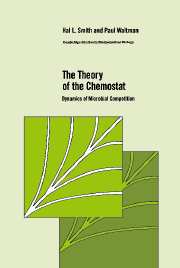Book contents
- Frontmatter
- Contents
- Preface
- 1 The Simple Chemostat
- 2 The General Chemostat
- 3 Competition on Three Trophic Levels
- 4 The Chemostat with an Inhibitor
- 5 The Simple Gradostat
- 6 The General Gradostat
- 7 The Chemostat with Periodic Washout Rate
- 8 Variable-Yield Models
- 9 A Size-Structured Competition Model
- 10 New Directions
- 11 Open Questions
- Appendices
- References
- Author index
- Subject index
6 - The General Gradostat
Published online by Cambridge University Press: 07 December 2009
- Frontmatter
- Contents
- Preface
- 1 The Simple Chemostat
- 2 The General Chemostat
- 3 Competition on Three Trophic Levels
- 4 The Chemostat with an Inhibitor
- 5 The Simple Gradostat
- 6 The General Gradostat
- 7 The Chemostat with Periodic Washout Rate
- 8 Variable-Yield Models
- 9 A Size-Structured Competition Model
- 10 New Directions
- 11 Open Questions
- Appendices
- References
- Author index
- Subject index
Summary
Introduction
In the previous chapter the gradostat was introduced as a model of competition along a nutrient gradient. The case of two competitors and two vessels with Michaelis–Menten uptake functions was explored in considerable detail. In this chapter the restriction to two vessels and to Michaelis–Menten uptake will be removed, and a much more general version of the gradostat will be introduced. The results in the previous chapter were obtained by a mixture of dynamical systems techniques and specific computations that established the uniqueness and stability of the coexistence rest point. When the number of vessels is increased and the restriction to Michaelis–Menten uptake functions is relaxed, these computations are inconclusive. It turns out that unstable positive rest points are possible and that non-uniqueness of the coexistence rest point cannot be excluded. The main result of this chapter is that coexistence of two microbial populations in a gradostat is possible in the sense that the concentration of each population in each vessel approaches a positive equilibrium value. The main difference with the previous chapter is that we cannot exclude the possibility of more than one coexistence rest point.
Throughout this chapter we rely extensively on the results contained in Appendices A, B, and C. The presentation here follows closely that in [STW] (see also the review [SW2]).
The most straightforward generalization of the work of Chapter 5 would be simply to extend the number of vessels from two to an arbitrary number, say n.
- Type
- Chapter
- Information
- The Theory of the ChemostatDynamics of Microbial Competition, pp. 129 - 158Publisher: Cambridge University PressPrint publication year: 1995



